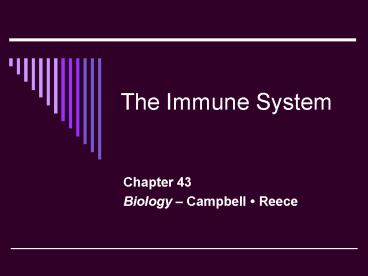The Immune System - PowerPoint PPT Presentation
1 / 20
Title:
The Immune System
Description:
The Immune System Chapter 43 Biology Campbell Reece Nonspecific Defenses First line of defense: Unbroken skin (minute cuts will allow the bacteria or virus ... – PowerPoint PPT presentation
Number of Views:138
Avg rating:3.0/5.0
Title: The Immune System
1
The Immune System
- Chapter 43
- Biology Campbell Reece
2
Nonspecific Defenses
- First line of defense
- Unbroken skin (minute cuts will allow the
bacteria or virus through) - Mucous membranes (line the digestive, respiratory
and genitourinary tracts) - Chemical secretions of skin and mucous membranes
- Lysozyme digests the cell walls of many bacteria
3
Nonspecific Defenses
- Second line of defense
- Phagocytic white blood cells (neutrophils,
macrophages, eosinophils) ingest the invading
organism - Antimicrobial proteins either attack directly
or inhibit reproduction - Inflammatory Response blood vessels dilate to
increase blood flow to the area, histamine is
released, blood clotting begins, phagocytes are
sent
4
Inflammatory Response
5
Specific Immunity
- Third line of defense
- Lymphocytes are the key cells of the immune
system - B lymphocytes (B cells) develops in the bone
marrow - T lymphocytes (T cells) differentiate under the
influence of the thymus - Primary immune response attack by the
lymphocytes the first time the body is exposed
6
Specificity of Lymphocytes
- Antigen a foreign molecule that elicits a
specific response - Antibodies proteins that recognize specific
antigens - Antigen receptors receptors on the B and T
cells that bind certain antigens
7
Clonal Selection
- When the antigen is recognized, the proper
lymphocyte is selected and cloned - Two forms of clones are produced
- Effector (plasma) cells short-lived cells that
secrete the specific antibody - Memory cells long-lived cells bearing receptors
for the same antigen
8
Clonal Selection
9
Secondary Immune Response
- When the individual is exposed to the same
antigen later, the response is much faster, of
greater magnitude, and more prolonged - The memory cells recognize the antigen and
produce a response more quickly
10
Distinguishing self from nonself
- The body will destroy any lymphocytes that bear
receptors for molecules already present in the
body - Failure to do this leads to autoimmune diseases
(such as multiple sclerosis) - Cells have special glycoproteins on their surface
called MHC (major histocompatibility complex) or
HLA (human leukocyte antigens) which mark body
cells as self
11
Distinguishing self from nonself
- Two types Class I MHC molecules and Class II
MHC molecules - Two types of T cells that responds to each kind
of MHC molecule - Cytotoxic T cells bind to cells with class I
MHC molecules - Helper T cells bind to cells with class II MHC
molecules - Triggers an immune response
12
Cytotoxic and Helper T cells
13
Cell-mediated Response
- Class I MHC molecules capture fragments of the
infecting agent and transport them to the surface
of the cell - These foreign particles are presented and a
cytotoxic T cell is activated - The cytotoxic T cell kills the infected cell
- The pathogen is now exposed to the antibodies
that will destroy it
14
Humoral Response
- Initiated when B cells bind with specific
antigens - B cells are activated by Interleukin-2 and other
cytokines secreted from the Helper T cells - The B cells then generate the plasma cells that
produce antibodies to destroy the pathogen
15
Antibody Structure Function
- The antigen has several different epitopes or
locations where an antibody can bind - A single antigen may bind several antibodies
16
Antibody Structure Function
- Antibodies are also called immunoglobulins
- Each molecule has four polypeptide chains two
identical heavy chains and two identical light
chains, joined by disulfide bridges to form a
Y-shaped molecule - Variable regions at the ends of the light and
heavy chains provide the specific binding site
17
Antibody Structure Function
18
Immunoglobulins
19
Antibody-Mediated Disposal of Antigen
- Neutralization the antibody binds to and blocks
the activity of the antigen - Opsonization the bound antibodies enhance
macrophage attachment to the pathogen - Agglutination clumping of the pathogen
- Complement fixation activation of the
complement system that leads to cell lysis
20
Antibody-Mediated Disposal of Antigen































